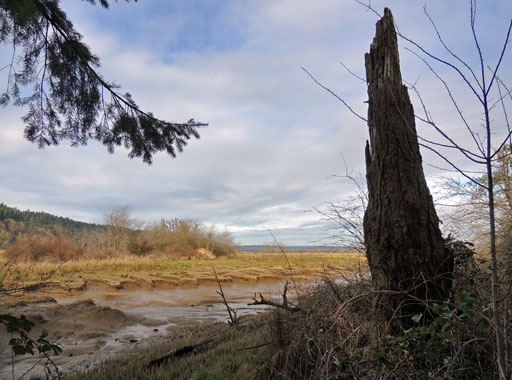By Laurie Tucker*
The Vashon Loop is grateful to the author and those involved with its writing, and to the Vashon-Maury Heritage Museum for permission to reprint this article.
In late December 1854, hundreds of Native people from villages in south Puget Sound gathered at šxʷnanəm (Medicine Creek), having been invited to a potlatch by Territorial Governor Isaac Stevens. They expected to receive gifts, in the tradition of their people. Instead, they were manipulated into ceding their territory of more than 2.56 million acres.
People from sx̌ʷəbabš villages of Vashon and Gig Harbor were present for the signing of the treaty on December 26, including Lucy Gerand and her family from Quartermaster Harbor. The canoe was their primary means of distance travel, but December is known to many of the south Sound peoples as “Time to Put the Paddles Away,” because of storms and risky conditions on the waters. Travel down to the Nisqually River area and erecting dry temporary housing would have been difficult in the cold, rainy winter.
The Native people suffered from other disadvantages. Between 1780 and 1840, diseases had decimated their population, reducing it by 50%, and severely impacting their traditional lifeways. In addition, American settlers had been rapidly moving into the south Sound area after Congress passed the Donation Land Act of 1850, with the population doubling between 1852 and 1853 in Washington Territory.
Increasing encroachment led to increasing hostilities. By the time of the treaty gathering, morale was low, and many Native people felt they had no choice but to sign. Because language use for the proceedings was Chinook jargon, a trade language of less than 700 words, actual concepts were poorly communicated.
When John Hiton, a leading man of the Puyallup, and credited by the anti-treaty Native leaders with being influential in getting the document signed, was asked why he signed the treaty if he believed it unfair, he stated,”There was no alternative. It was that or destruction by the whites. It was better to be left with something.”(Richard White, The Treaty at Medicine Creek)
“Every one of them recognized that there was no power that could protect them from the encroachment of the white settlers, save…the Government of the United States…which had possession of the whole country and could do as they pleased with it.” (Colonel Benjamin Shaw, The Puyallup Tribal News, December 8, 2011)
Many of the sx̌ʷəbabš people, forced by the treaty to leave their homes on Vashon-Maury Islands, moved to the Puyallup Reservation to start over. While the treaty promised that Native people could continue to fish in their usual and accustomed places, it took the Boldt Decision of 1974 to uphold those rights in the courts.
Today, the Puyallup Tribe is a strong, thriving, sovereign nation of over 5,000 members, and is one of the largest employers in Pierce County. With perseverance and courage, the Puyallup Tribe continues to care for its members and sustain a good way of life for future generations.
* This article was written by Laurie Tucker with support from Rayna Holtz. They received guidance from Brandon Reynon, Puyallup Tribal Historic Preservation Officer.

